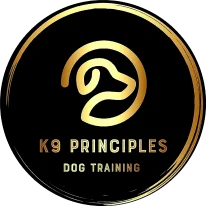Training a dog is often thought of as a straightforward process of teaching cues, correcting mistakes, and reinforcing good behaviour. Many dog owners arrive at their first session expecting a mechanical exchange: they say “sit”, the dog complies, and a treat is delivered. But in truth, effective dog training runs far deeper. At its heart lies an emotional connection — one that shapes trust, communication, and resilience between owner and dog. In Hamilton, countless families discover this truth through K9 Principles, where we see every day that emotions drive outcomes more than cues or equipment ever could. When people search for dog training in Hamilton, they’re rarely just looking for a service. They’re seeking understanding, guidance, and a way to build a lasting relationship with their dog — one built on more than cues, but on genuine emotional balance.
Why Emotions Matter in Dog Training
To fully appreciate why emotions matter, we must acknowledge that dogs are not machines. They are living beings with emotional landscapes that affect how they learn, respond, and adapt. Just as a child struggling with anxiety will find it harder to concentrate in school, a dog who feels stressed or fearful will struggle to absorb lessons in training. On the flip side, a confident and joyful dog can flourish, picking up cues faster and maintaining those skills under pressure.
At K9 Principles, we remind owners that Hamilton dog training is not simply about technical precision but about fostering a state of mind in both dog and human that encourages learning. A dog that trusts its handler will attempt new behaviours, tolerate mistakes, and recover quickly when confused. An owner who trains from a place of calm will communicate with clarity and patience. Together, these emotional states create harmony — a space where learning doesn’t just happen but thrives.
The Emotional Lens of a Dog
It’s easy to forget that dogs view the world through a sensory and emotional filter that doesn’t match our own. While we use words and reasoning, dogs rely heavily on body language, tone, and consistency of experience. When a dog encounters a new situation, its emotional response — whether fear, curiosity, or excitement — drives behaviour more than conscious thought.
Imagine a puppy in Hamilton encountering Bayfront Park for the first time. The environment is busy: cyclists, children, dogs, the scent of the lake. If the puppy’s emotional state is balanced, with curiosity outweighing fear, the experience becomes a valuable training opportunity. But if the puppy feels overwhelmed and anxious, no amount of cue-giving will result in reliable behaviour. Understanding this emotional perspective is essential in all dog training. It shifts the focus from controlling behaviour to shaping emotions first, ensuring that the dog feels safe and capable before expecting compliance.
Owner Emotions: The Mirror Effect
Dogs are extraordinary at reading humans. Studies have shown that dogs can pick up on human emotions not just through body language but even through scent, detecting changes in our chemical state when stressed or calm. This means that when an owner feels frustrated or anxious, their dog doesn’t just notice — it feels it.
This “mirror effect” plays a huge role in training outcomes. A dog attempting loose-lead walking with an owner who is tense will often pull harder, misreading the human’s rigidity as pressure to move forward. Conversely, when the same exercise is conducted with a relaxed owner, the dog is more likely to stay in tune, sensing the calm rhythm.
This is why emotional awareness in training is vital. At K9 Principles, we coach owners in Hamilton not just on mechanics but on mindset. Staying patient, breathing through frustration, and viewing mistakes as part of the process allows owners to project calm energy. That calmness becomes contagious, guiding the dog toward balance.
Building Trust as the Emotional Cornerstone
Trust is the bedrock of any relationship, and dog training is no different. Without trust, every cue, correction, or reward becomes uncertain. With trust, even difficult lessons feel manageable.
Trust develops when dogs experience consistency. If every “come” cue is followed by praise or reward, the dog learns that responding is safe and beneficial. But if “come” sometimes leads to punishment — for instance, being called in only to have playtime end — trust is eroded. Dogs quickly learn which environments and interactions feel secure, and this emotional foundation determines how willing they are to try, fail, and try again. 
At K9 Principles, trust-building isn’t left to chance. It is deliberately woven into every exercise, from first sit to advanced recall. We explain to Hamilton owners that reliable dog training in Hamilton doesn’t stem from demanding obedience but from demonstrating fairness. The dog must always feel that working with its owner leads to positive, predictable outcomes.
The Emotional Journey of New Dog Owners
For many first-time dog owners in Hamilton, the training journey is emotionally overwhelming. There’s the excitement of welcoming a new puppy or rescue, but also the guilt when mistakes are made, the frustration when progress feels slow, and the doubt when behaviours spiral out of control. These emotions are natural, but without guidance they can cloud decision-making.
It’s common for owners to worry that they are “ruining” their dog if they mishandle a situation. The truth is that dogs are incredibly forgiving. What matters is not perfection but persistence and adjustment. At K9 Principles, we encourage owners to view their emotions with compassion, recognising that frustration, guilt, or anxiety are not signs of failure but stepping stones toward greater awareness. By supporting the human side of training, we help families overcome the emotional hurdles that might otherwise stall their progress.
Recognising Stress in Dogs
Part of the emotional side of training is learning to read subtle signs of stress before they escalate. A dog under pressure rarely goes from calm to chaos instantly. Instead, there are signals: lip-licking, yawning, turning away, excessive sniffing. These are the dog’s attempts to self-soothe, much like a human tapping their foot before speaking in public.
 Owners who miss these signals may push too far, leading to barking, lunging, or avoidance. Recognising them early allows for timely breaks, reassurance, or redirection. For example, if a dog in Hamilton is struggling during a busy market exposure, noticing the early stress signs and stepping aside for a breather prevents emotional overwhelm. This respect for the dog’s emotional threshold is what separates generic dog training from true emotional partnership.
Owners who miss these signals may push too far, leading to barking, lunging, or avoidance. Recognising them early allows for timely breaks, reassurance, or redirection. For example, if a dog in Hamilton is struggling during a busy market exposure, noticing the early stress signs and stepping aside for a breather prevents emotional overwhelm. This respect for the dog’s emotional threshold is what separates generic dog training from true emotional partnership.
Harnessing Positive Emotions in Training
Positive emotions act as fuel for learning. When training feels like a game, behaviours are learned faster and retained longer. Joy, play, and celebration aren’t “extras” — they are central to success.
Consider a recall session in a Hamilton park. If the dog returns to its owner and receives not just a treat but a joyful burst of praise and play, the emotional impact is enormous. That positive association makes the recall stronger than any food reward alone. Dogs remember how experiences felt, and emotional highs help secure behaviours in memory.
 This is why K9 Principles encourages owners to embrace enthusiasm. We teach that praise should feel genuine, not robotic. The more the dog senses delight in its success, the more likely it is to repeat the behaviour.
This is why K9 Principles encourages owners to embrace enthusiasm. We teach that praise should feel genuine, not robotic. The more the dog senses delight in its success, the more likely it is to repeat the behaviour.
The Costs of Negative Emotions in Training
While positive emotions build success, negative emotions like fear, frustration, and anger can erode it. Outdated training methods that rely on intimidation may produce short-term compliance, but they leave emotional scars. A dog that learns “sit” through harsh corrections may obey, but it obeys out of fear, not trust. This fragile obedience often crumbles when stress increases, leading to reactive or avoidant behaviour later.
Equally damaging are the emotions owners carry. Training from a place of anger leads to inconsistency and overreaction. It also damages the owner–dog bond, as the dog learns to associate its handler with unpredictability. At K9 Principles, we emphasise to Hamilton clients that training is not about domination but cooperation. Negative emotions shut down cooperation, while positive ones create lifelong reliability.
Resilience in Dog Training
Resilience is the ability to recover from setbacks without fear or loss of confidence. Dogs, like people, need resilience to succeed in learning. A resilient dog doesn’t collapse emotionally after a mistake. Instead, it tries again.
Resilience is built through careful emotional management. Mistakes are treated as neutral, successes as celebrated. For owners, resilience means letting go of guilt when things go wrong, and instead viewing each setback as a stepping stone toward mastery. When both dog and human adopt resilience, Hamilton dog training sessions become less about perfect execution and more about steady progress.
The Science of Emotional Contagion
One of the most fascinating aspects of dog training is the phenomenon of emotional contagion — the transfer of emotional states from one being to another. Research shows that dogs not only notice human emotions but synchronise with them. If you’ve ever found your dog settling when you relax, or becoming agitated when you’re stressed, you’ve witnessed emotional contagion in action.
In training, this means your state of mind is as important as the cue you give. If you attempt recall while anxious about whether your dog will respond, the dog senses the tension and hesitates. If you attempt it with relaxed confidence, your dog feels that assurance and is more likely to succeed. At K9 Principles, we coach Hamilton owners to recognise their own emotional signals, reminding them that every leash, voice tone, and posture communicates more than words ever could.
Training as a Shared Emotional Experience
When training is approached with emotional awareness, it transforms from a chore into a shared journey. Every milestone — the first successful sit, the first calm walk, the first off-lead recall — becomes a celebration for both dog and human. These moments strengthen the bond far beyond simple obedience.
In Hamilton, we’ve seen countless families beam with pride when their dogs achieve new skills. The joy radiates in both directions: the dog thrives on the owner’s delight, and the owner feels rewarded by the dog’s progress. This is why we insist that Hamilton dog training is about more than results. It’s about memories, confidence, and a deeper partnership that lasts a lifetime.
Case Studies: Emotional Transformations
One rescue dog in Hamilton arrived terrified of strangers. Through patient exposure, gentle reinforcement, and calm emotional leadership, the dog transformed from trembling in corners to happily greeting visitors. The training wasn’t about commands but about rebuilding emotional safety.
A confident puppy from another family struggled with impulse control. The owner felt overwhelmed, worried that they were failing. By focusing on managing the owner’s emotional responses — teaching patience, celebrating small wins, and maintaining calm consistency — the puppy blossomed into a reliable companion, and the owner gained newfound confidence in leadership.
A third example comes from an older dog who had developed separation anxiety. By guiding the family to recognise emotional triggers, create secure routines, and manage their own stress when leaving, we helped reshape the dog’s emotional associations. What once felt like chaos became calm, built not on commands but on trust.
The K9 Principles Philosophy
At K9 Principles, we believe that dog training in Hamilton must always address the emotional side of learning. Our approach is built on connection before correction, empathy before expectation. We know that every dog has a unique emotional world, and every owner brings their own mindset into the process. That’s why our training isn’t one-size-fits-all. It’s tailored to the dog–human team in front of us, blending technical skill with emotional awareness.
Our success as trusted trainers for the Hamilton/Burlington SPCA stems from this philosophy. Families trust us not just to teach their dogs commands, but to guide them through the emotional journey of building a relationship. When training feels overwhelming, we provide clarity. When doubt creeps in, we provide reassurance. And when success is achieved, we celebrate alongside our clients, because every milestone is as emotional for us as it is for them.
Practical Strategies for Emotional Balance
For owners, emotional balance begins with self-awareness. Recognising when frustration is rising and pausing before it spills over can prevent a negative spiral. Breathing exercises, taking breaks, or shifting perspective can reset the emotional tone.
For dogs, balance comes from safe spaces, appropriate outlets, and fair reinforcement. Allowing a dog time to decompress after a stressful session prevents burnout. Building routines that combine mental stimulation, exercise, and rest ensures a stable emotional state.
At K9 Principles, we encourage Hamilton families to make emotional care part of daily routines. Just as a dog needs food and water, it needs consistent reassurance, clarity, and opportunities to feel successful. These small daily investments pay off in training reliability and long-term harmony.
The Lasting Benefits of Emotionally-Aware Training
When emotions are acknowledged, training becomes sustainable. Dogs learn to trust their handlers fully, owners gain confidence, and the partnership strengthens beyond obedience. A dog trained with emotional awareness is not just well-behaved but truly balanced — able to handle real-world pressures, from busy Hamilton streets to quiet family gatherings.
Owners benefit too. Instead of feeling at war with their dog, they feel in tune, capable of guiding with calm authority. This emotional connection is what makes training results last for years, not weeks. It is why so many families in Hamilton recommend K9 Principles as the go-to choice for Hamilton dog training.

So if you’re searching for dog training in Hamilton that goes deeper than obedience, look no further than K9 Principles. Together, we’ll not just train your dog — we’ll strengthen the emotional foundation that makes training truly last.
Contact us for more information:
- Name: K9 Principles
- Address: Haldimand County, Greater Hamilton Area, Burlington, and Most of Norfolk County
- Phone: 289 880-3382
- Email: k9principlesinc@gmail.com
- Website: www.k9principles.ca
FAQs
-
A1. Yes, dogs are highly sensitive to human emotions. They read your body language, tone, and even scent. Your calmness encourages balance, while your stress can heighten their anxiety.





